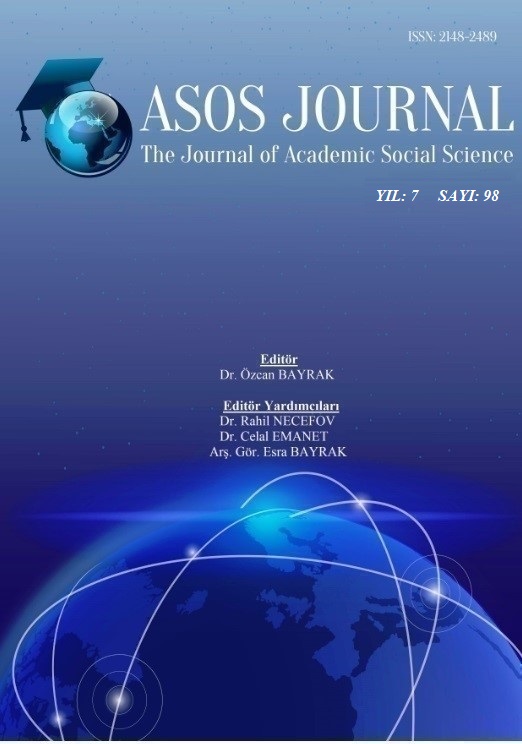LİSE ÖĞRENCİLERİNİN SOSYAL DESTEK İLE FİZİKSEL AKTİVİTE DÜZEYLERİNİ ARASINDAKİ İLİŞKİNİN İNCELENMESİ
Author :
Abstract
İnsanlar doğumlarından itibaren toplumdaki diğer bireylerle etkileşim içerisinde yaşarlar. Bu sebeple insanlar arasında gelişen sosyal ilişkilerin bireylerin yaşam standartları üzerinde ciddi etkiye sahiptir. Zira sosyal ilişkilerin istendik yönde olmaları durumunda bireyin hem yaşamsal hem de psikolojik iyi oluş halleri istendik yönde olurken, ilişkilerin olumsuz olması durumunda aksi bir sonuç gözlemlenir. Bireyler herhangi bir sorunla karşılaştıklarında ve stres düzeylerini yükselten bir durum meydana geldiğinde çevrelerinde onlara yardımcı olacağını bildiği insanların olmasını isterler. Bu noktada devreye sosyal destek kavramı girmektedir. Sosyal destek, bireyin ihtiyaç duyduğu durumlarda diğer birey ve kurumlardan elde ettiği maddi ve manevi yardımların tümü olarak tanımlanabilir. Bireyin hayatını olumlu etkileyen konulardan biri de fiziksel aktivitedir. Özellikle günümüzde teknolojinin getirdiği yenilikler bireylerin fiziksel olarak daha pasif olmalarına neden olmaktadır. Bu durum ise ciddi sağlık sorunlarının ortaya çıkması ile sonuçlanabilir. Bu çalışmanın amacı, lise öğrencilerinde sosyal destek ile fiziksel aktivite arasındaki ilişkinin incelenmesidir. Çalışmanın amacına ulaşmak için anket yöntemi kullanılmış ve 980 öğrenci üzerinde uygulanmıştır. Elde edilen sonuçlara göre sosyal destek ile fiziksel aktivite arasında ilişki vardır.
Keywords
Abstract
People have regular interactions with other people from birth. As a result of that fact, social relationships between people affect life standards of a single person. When there are good relationship between a person and other people around him/her, that person has better life standards and physical and emotional well-being level increases. On the contrary, when that person has negative social relationships with other people, there becomes a decrease at life standards and physical and emotional well-being. A person wants to know that there are people ready to help him/her when he/she faces with difficulties and when stress level increases. Social support becomes an important term at those points. Social support may be described as sum of material and emotional support a person get from other people and institutions when needed.Another important topic affecting life of a person is physical activity. Especially nowadays, outcomes of technological developments make people inactive. That situation may result in serious health problems. At that study, it is aimed to examine relationship between social support and physical activity at high school students.In order to reach the aim of the study, Survey technique is used with 980 students. At the end of the study, it is seen that there is a relationship between social support and physical activity.
Keywords
- Aşçı, H., Tüzün, M. ve Koca, C. (2006). An examination of eating attitudes and physical activity
- Aşçı, H., Tüzün, M. ve Koca, C. (2006). An examination of eating attitudes and physical activitylevels of Turkish University students with regard to self-presentational concern. Eating Behaviors 7, 362–367.
- Balcı, V., ilhan, A. (2006) Türkiye'deki Üniversite Öğrencilerinin Rekreatif Etkinliklere KatılımDüzeylerinin Belirlenmesi. SPORMETRE Beden Eğitimi ve Spor Bilimleri Dergisi, 4(1), 11-18.Brown, D. W., Balluz L. S. ve Heath, G. W. (2003). Associations between recommended levelsof physical activity and health-related quality of life. Findings from the 2001 behavioral risk factor surveillance system (BRFSS) survey. Prev Med.,37: 520–8.
- Cengiz, C. (2007). Physical activity and exercise stages of change levels of middle east technical university students. [Bilim uzmanlığı tezi]. Middle East Technical University. Ankara
- Crocker, P. R. E., Eklund, R. C., & Kowalski, K. C. (2000). Children’s physical activity and physical self-perceptions. Journal of Sport Science, 18, 383–394.
- Dolaşır-Tuncel, S., Tuncel F. (2009) Determining the Health-Exercise/Physical Activity Levelsof the Turkish University Students. Celal Bayar Üniversitesi, Beden Eğitimi ve Spor Bilimleri Dergisi, 4(1), 51-58.
- Ebem, Z. (2007). Health promotıng behavıors and exercıse stages of change levels of students attransıtıon to unıversıty. Yayınlanmamış Yüksek Lisans Tezi, Orta Doğu Teknik Üniversitesi, Sosyal Bilimler Enstitüsü.
- Eker D, Arkar H (1995) Çok boyutlu algılanan sosyal destek ölçeğinin faktör yapısı, geçerlik ve güvenirliği. Turk Psikol Derg; 34:45–55
- Hagger, M. S., Ashford, B., ve Stambulova, N. (1998). Russian and British children's physicalself-perceptions and physical activity participation. Pediatric Exercise Science, 10, 137-152.
- Hayes, S. D., Crocker, P. R. E., & Kowalski, K. C. (1999). Gender differences in physical self-perceptions, global self-esteem and physical activity: Evaluation of the physical selfperception profile model. Journal of Sport Behavior, 22, 1– 14.
- Karasar, N. (2012). Bilimsel araştırma yöntemi (23 ed.). Ankara: Nobel Yayıncılık.
- Özdemir, R. A., Çuğ, M. ve Çelik, Ö. (2010). Genç yetişkin üniversite öğrencilerinde farklı türdeegzersiz uygulamalarının sosyal fizik kaygı düzeyine etkisi. Hacettepe Journal of Sport Sciences. 21 (2), 60–70.
- Ross, J. G., & Pate, R. R. (1987). The national children and youth fitness study II: A summary of findings. Journal of Physical Education, Recreation and Dance, 58, 51–56.
- Savcı, S., Öztürk, M., Arıkan, H., inal-ince, D., Tokgözoğlu, L. (2006). Physical Activity Levels of University Students. Archieves of Turkish Cardiology, 34, 166-172.
- Steptoe, A., Wardle, J., Fuller, R., Holte, A., Justo, J., Sanderman, R., Wichstrom, L. (1997).Lelsure-Time Physical Exercise: Prevalence, Attltudinal Correlates and Behavioral Correlates Among Young Europeans From 21 Countries. Preventive Medicine, 26, 845-54.
- Zimet, G., Dahlem, N., Zimet, S. ve Farley, G. (1988). The Multidimensional Scale of the Perceived Social Support. Journal of Personality Assesment. 55, 610-617.





